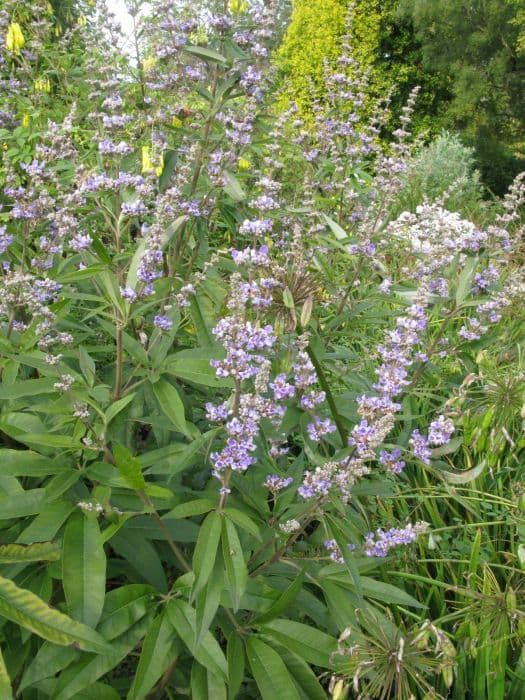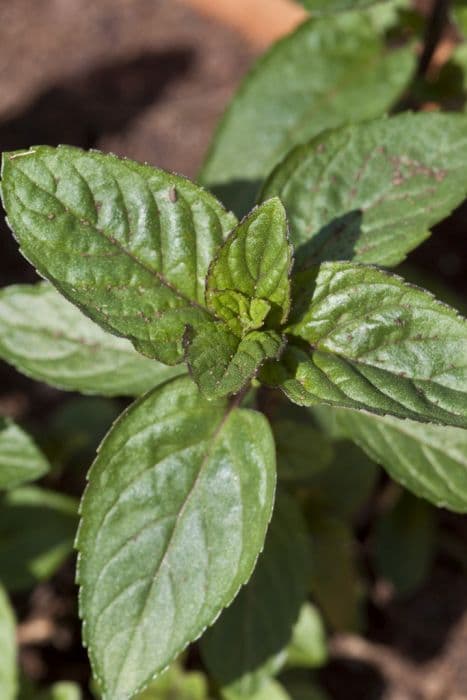Ground ivy Glechoma hederacea

ABOUT
Glechoma hederacea, commonly known as ground ivy, is a perennial plant with a creeping growth habit that allows it to spread over large areas. Its stems are square-shaped and trail along the ground, often rooting at the nodes. The leaves of ground ivy are quite distinctive, with a kidney or heart shape, and possess scalloped edges. They are known for their plush, velvety texture and can range in color from green to purplish-green, depending on various factors such as light exposure. Ground ivy flowers are small, tubular, and typically a violet or purple color, with a lipped shape that is attractive to many nectar-seeking insects. The flowers emerge in clusters from the leaf axils and can add a subtle splash of color to the environments where this plant grows. The overall appearance of ground ivy is lush and can provide an evergreen groundcover in some regions, with its leaves persisting for much of the year. Despite its attractive features, ground ivy is often considered an invasive weed in many areas due to its vigorous growth and ability to outcompete other plants for resources.
About this plant
 Names
NamesFamily
Lamiaceae
Synonyms
Ground Ivy, Creeping Charlie, Gill-Over-The-Ground, Alehoof, Tunhoof, Catsfoot, Field Balm, Run-Away-Robin
Common names
Glechoma hederacea var. micrantha, Glechoma hederacea var. parviflora, Nepeta glechoma Benth., Nepeta hederacea (L.) Trevis., Glechoma hederacea subsp. grandis (Vill.) Nyman, Glechoma grandis Vill.
 Characteristics
CharacteristicsLife cycle
Perennials
Foliage type
Deciduous
Color of leaves
Green
Flower color
Purple
Height
0 feet 6 inches (15 cm)
Spread
1 foot 0 inches (30 cm)
Plant type
Herb
Hardiness zones
4-9
Native area
Europe Asia
Benefits
 General Benefits
General Benefits- Groundcover: Glechoma hederacea, commonly known as ground ivy, is often used as an evergreen groundcover, filling in areas where turf grass may struggle to grow.
- Erosion control: Ground ivy helps to prevent soil erosion in sloped areas due to its dense mat-forming growth habit.
- Pollinator attraction: The flowers of ground ivy attract various species of bees and other pollinators, supporting local ecosystems.
- Aesthetic appeal: With its attractive scalloped leaves and violet flowers, ground ivy can add visual interest to garden spaces.
- Shade tolerance: Ground ivy thrives in shady areas where sunlight is limited, making it useful for landscaping under trees or in other low-light conditions.
- Culinary use: Leaves of ground ivy are sometimes used in small quantities as a flavoring agent in cooking, particularly in traditional European cuisine.
 Medical Properties
Medical Properties- Expectorant: Traditionally used to help clear mucus from the respiratory tract.
- Anti-inflammatory: Contains compounds that may reduce inflammation.
- Mild Astringent: Can be used for minor wounds or skin irritations to constrict tissues and reduce discharge.
- Diuretic: Promotes the production of urine, aiding in the elimination of excess fluid from the body.
- Antioxidant: Has potential antioxidant properties which could help protect cells against damage from free radicals.
- Antimicrobial: Some components in the plant may have antimicrobial effects against certain pathogens.
- Diaphoretic: Induces perspiration, which can theoretically assist in fever management.
- Gastrointestinal Relief: May help to alleviate some digestive issues such as indigestion or gastrointestinal discomfort.
 Air-purifying Qualities
Air-purifying QualitiesThis plant is not specifically known for air purifying qualities.
 Other Uses
Other Uses- Glechoma hederacea, commonly known as ground ivy, has historically been used to clarify and flavor beer before the introduction of hops, due to its antiseptic and preservative properties.
- The plant can be used as a natural dye, providing a subtle green hue to textiles when used in the dyeing process.
- Ground ivy has been used in folk traditions in the form of a poultice or ointment to soothe the skin after insect bites or stings.
- In the kitchen, young ground ivy leaves can be incorporated into salads or soups for a mild, aromatic flavor.
- When dried, ground ivy can be used to make a herbal sachet, which will impart a pleasant fragrance to drawers and wardrobes.
- Ground ivy can be included in potpourri mixtures for its attractive look and minty aroma, contributing to the overall scent profile.
- The plant is used in some gardening circles as a natural ground cover, to prevent soil erosion because of its dense mat-forming growth habit.
- Due to its creeping growth and attractive flowers, ground ivy is sometimes grown for ornamental purposes in fairy gardens or as part of a shade garden underplanting.
- Some beekeepers value ground ivy as it produces flowers that are a good nectar source for bees in early spring, thus supporting pollinator populations.
- As a companion plant, ground ivy is said to help repel certain insects and pests in the garden, thereby protecting nearby plants.
Interesting Facts
 Feng Shui
Feng ShuiGround ivy is not used in Feng Shui practice.
 Zodiac Sign Compitability
Zodiac Sign CompitabilityGround ivy is not used in astrology practice.
 Plant Symbolism
Plant Symbolism- Survival and Resilience: Glechoma hederacea, commonly known as ground ivy, can thrive in diverse environments and conditions, symbolizing an individual's ability to survive and adapt to various challenges in life.
- Healing: Ground ivy has a history of medicinal use, ranging from treating cough to ear infections, representing healing and the power of nature in addressing ailments.
- Insight: In some cultural folklore, ground ivy is thought to help clear the mind and grant clarity, symbolizing insight and the uncovering of hidden truths.
- Persistence: As an invasive species, ground ivy is exceptional at spreading and covering ground, symbolizing tenacity and the will to persist in the face of obstacles.
- Connection: Its ability to form dense mats that connect large areas can represent the idea of interconnectedness and the importance of community and relationships in providing support.
 Water
WaterGround ivy, commonly known as Creeping Charlie or Glechoma hederacea, prefers consistent moisture without being waterlogged. It should be watered when the top inch of soil feels dry to the touch. Generally, this might translate to watering once or twice a week, depending on the climate and weather conditions. Use around half a gallon of water per square yard for each watering session, ensuring not to flood the plant. Overwatering can lead to root rot, so it's crucial to provide good drainage.
 Light
LightCreeping Charlie thrives in partial shade to full sun. It performs best when given several hours of filtered sunlight a day, though it can tolerate full sun if it isn't scorching. The ideal spot would be a location that receives some shade, particularly during the hottest part of the day, to prevent leaf scorch.
 Temperature
TemperatureCreeping Charlie is hardy and can withstand a broad range of temperatures, surviving the winter in temperatures as low as 20 degrees Fahrenheit. The optimal growth temperature for Creeping Charlie is between 60 and 70 degrees Fahrenheit. However, it can still grow at higher temperatures if adequate water is provided.
 Pruning
PruningCreeping Charlie should be pruned to maintain the desired shape and size, and to prevent it from overtaking other plants in the garden. Pruning can be done at any time of the year, but the best time is in the spring or early summer, which encourages new growth. It can be pruned as often as needed to control its spread.
 Cleaning
CleaningAs needed
 Soil
SoilGround ivy thrives in a well-draining, moist soil mixed with organic matter. The best pH for this plant should be between 6.0 and 7.5. A mix of garden soil, peat moss, and perlite can provide an optimal environment for growth.
 Repotting
RepottingGround ivy is a vigorous grower and may not need frequent repotting. Repot every 2-3 years or when it becomes root-bound, ensuring minimal disruption to the plant's natural spreading behavior.
 Humidity & Misting
Humidity & MistingGround ivy prefers moderate humidity levels but is quite adaptable and can tolerate a range of humidity conditions as long as it is not overly dry.
 Suitable locations
Suitable locationsIndoor
Place ground ivy in indirect light, keep soil moist, and ensure good air circulation.
Outdoor
Plant ground ivy in partial shade, enrich soil with compost, water regularly.
Hardiness zone
3-10 USDA
 Life cycle
Life cycleGround Ivy (Glechoma hederacea) begins its life cycle as a seed, germinating in cool, moist soil usually in spring but sometimes in fall. From germination, it develops into a seedling, characterized by the emergence of its cotyledons, followed by the true leaves displaying its distinctive kidney or heart shape. Ground Ivy is a perennial, so once it has established a root system, it enters a vegetative state where it grows and spreads vigorously via stolons, allowing it to form dense mats. These runners can root at the nodes, creating new plants. Following vegetative growth, it enters the reproductive stage, flowering in spring with small, tubular, lavender to purple flowers that aid in pollination through insects such as bees. After pollination, the plant produces tiny nutlets as fruit, completing its life cycle and dispersing seeds for the next generation of growth.
 Propogation
PropogationPropogation time
Spring-Early Summer
Ground ivy, known scientifically as Glechoma hederacea, is commonly propagated through stem cuttings. This method is widely favored due to its simplicity and high success rate. It involves taking a 3 to 5 inch (approximately 7.6 to 12.7 cm) cutting from a healthy, established plant during the spring or early summer when the plant is actively growing. The cutting should include at least one node, which is the point where leaves emerge. The lower leaves are removed, and the cut end is then placed in a rooting medium such as moist potting soil. To encourage rooting, the environment should maintain high humidity, which can be achieved by covering the cutting with a plastic bag or dome. After a few weeks, the cutting should develop roots and can be transplanted to a suitable location outdoors.









